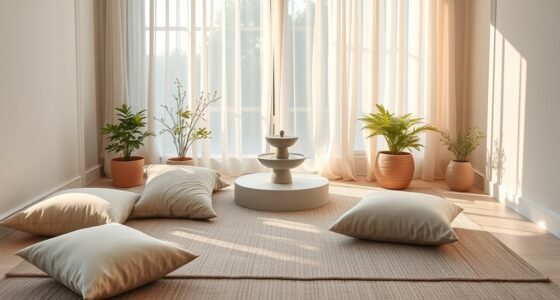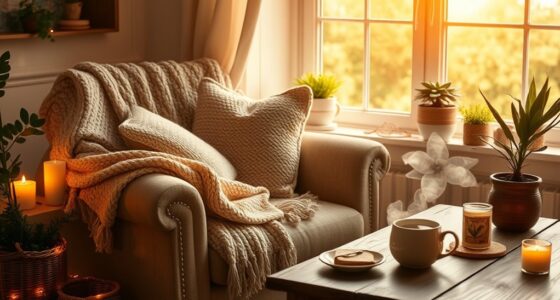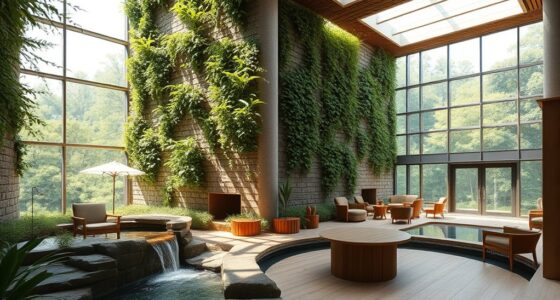Nostalgia in home décor influences your feelings by activating pleasure and memory centers, making your space feel comforting and secure. Personal items, vintage furniture, and familiar scents create emotional bonds that boost your mood and resilience. Incorporating retro styles or meaningful memorabilia can evoke positive memories, helping you relax and feel connected. If you keep exploring, you’ll discover how balancing these sentimental elements with modern design can truly enhance your well-being.
Key Takeaways
- Nostalgic home décor activates brain regions associated with pleasure and memory, enhancing mood and emotional well-being.
- Personal memorabilia evoke positive memories, fostering comfort, security, and emotional resilience.
- Nostalgic elements create a sense of safety and familiarity, reducing stress and promoting relaxation.
- Incorporating cultural and historical motifs fosters a sense of belonging and identity through meaningful décor choices.
- Blending nostalgic items with modern design supports emotional expression and a balanced, harmonious living environment.
Understanding Nostalgia’s Emotional Impact

Nostalgia in home décor deeply influences your emotions by activating brain regions linked to pleasure and memory, such as the hippocampus and amygdala. When you incorporate nostalgic elements, you trigger emotional responses that can brighten your mood and create a sense of comfort. The emotional impact of nostalgia helps reduce tension and sadness by fostering familiarity and emotional security. Personal objects or design details connected to meaningful memories strengthen your sense of belonging and support mental well-being. These nostalgic décor choices often evoke positive feelings from childhood or important life moments, promoting overall mood improvement. Additionally, understanding mindfulness principles can enhance the sensory experience of nostalgic spaces through carefully curated auditory elements. Recognizing how city dynamics influence emotional responses can help tailor nostalgic décor to better suit your personal environment. By tapping into this emotional power, your home can become a sanctuary of comfort, resilience, and identity amid life’s inevitable changes.
The Connection Between Memories and Well-Being

Your home décor choices can profoundly influence your emotional well-being by anchoring you to meaningful memories. When you include personal memorabilia and familiar visual cues, you activate positive memories that foster comfort and security. These nostalgic elements can boost your emotional resilience, helping reduce feelings of anxiety and sadness. Reminiscing about past experiences has been linked to increased happiness and overall psychological well-being. Sensory triggers like familiar scents and images in your home evoke emotional responses that enhance mood and mental health. Incorporating anime-inspired décor can add a unique and joyful touch that resonates with your interests. Additionally, integrating antique pieces can deepen the nostalgic atmosphere, creating a layered and textured environment. Engaging with spiritual practices such as meditation or creating altars can also amplify the sense of connection and peace within your space. Exploring creative practice in your décor arrangement can foster a more personalized and meaningful environment. Understanding the importance of emotional well-being can help you intentionally design spaces that nurture your mental health. By surrounding yourself with nostalgic décor, you strengthen social bonds through shared memories and conversation starters. Ultimately, your environment becomes a supportive space that nurtures your well-being by connecting you to the joyful and comforting moments from your past.
How Nostalgic Decor Elicits Comfort and Security
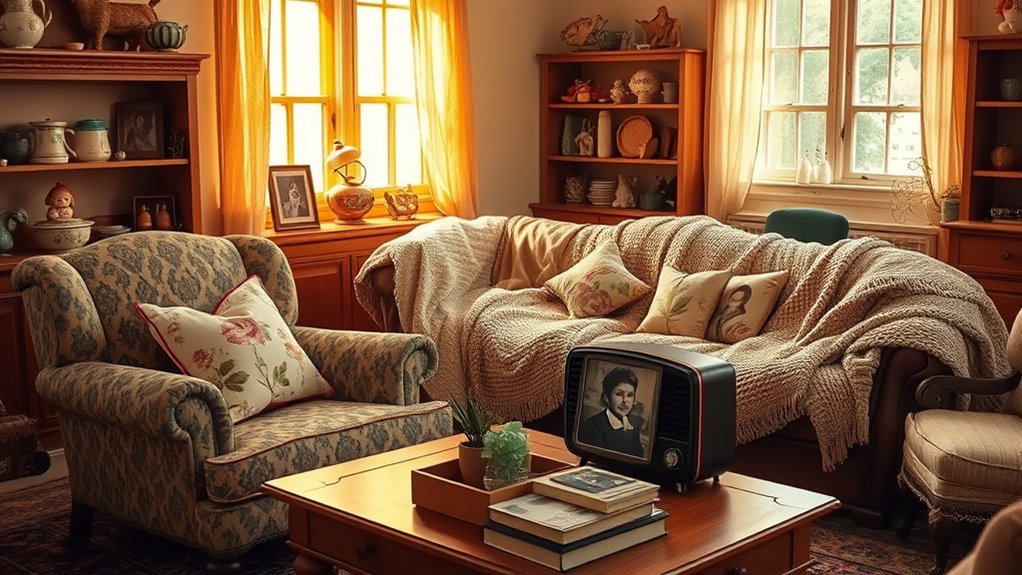
When you incorporate nostalgic decor into your home, it actively triggers positive emotional responses by bringing familiar memories to mind. This sense of nostalgia fosters feelings of safety and comfort, making your home a sanctuary. To enhance these effects, consider:
- Displaying vintage furniture or heirlooms that remind you of loved ones or childhood.
- Using familiar colors and patterns that evoke past eras or personal memories.
- Incorporating sentimental objects that hold personal significance.
- Creating spaces that encourage social bonds, reinforcing a sense of belonging.
- Being mindful of cybersecurity risks associated with sharing personal memorabilia online, ensuring your sentimental items remain protected from digital threats.
- Additionally, integrating music therapy elements such as familiar tunes can further deepen emotional connections and promote relaxation within your space. Recognizing the impact of emotional memory activation can also help tailor your decor choices to maximize comfort. Engaging with celebrity lifestyle trends can inspire unique ways to personalize your nostalgic decor, blending popular influences with your own memories. Incorporating brain’s memory centers in your design choices can amplify the nostalgic effect and strengthen emotional bonds.
These nostalgic elements activate your brain’s memory centers, reducing stress and promoting well-being. As a result, your home becomes more than just a space—it transforms into an emotionally stable environment where comfort and security naturally thrive through the power of nostalgia.
The Role of Sensory Triggers in Creating Emotional Responses
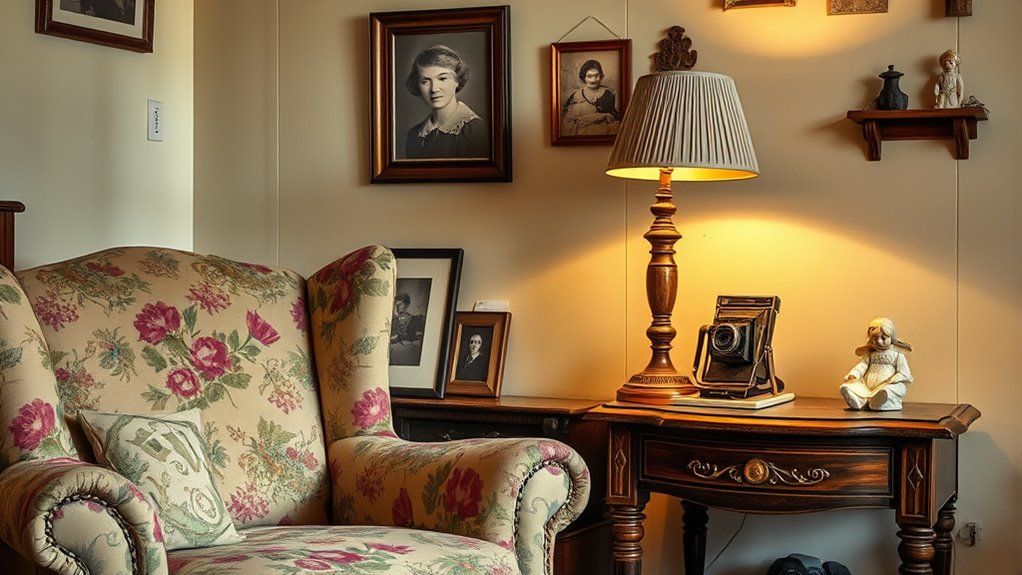
Sensory triggers like scents, tastes, and visuals can instantly stir memories and emotional responses. When you incorporate familiar aromas or vintage objects, they create a sense of comfort and familiarity. These cues make your space feel more emotionally connected and inviting. For example, incorporating essential oils such as lavender or eucalyptus can enhance this effect by evoking specific memories and feelings. Additionally, understanding market trends can help you select décor elements that resonate emotionally while remaining stylish. The use of AI-driven discoveries in healthcare and other fields also underscores the importance of familiarity and trust in emotional well-being. Recognizing the role of comfort solutions can further deepen the emotional impact of your décor choices. Incorporating personalized décor that reflects your unique experiences can strengthen this connection and foster a welcoming environment.
Aromas Evoke Memories
Aromas have a powerful ability to trigger memories and evoke deep emotional responses because of their direct connection to the brain’s limbic system. When you encounter familiar scents, such as grandma’s perfume or freshly baked bread, they can instantly bring back vivid memories filled with feelings of comfort, security, and happiness. These aromas act as emotional anchors, reinforcing nostalgia and personal identity. To deepen this connection in your home décor, consider: 1. Incorporating vintage perfumes or scented candles that evoke your past. 2. Using traditional spices in your kitchen to trigger warm memories. 3. Displaying heirloom items with familiar scents. 4. Creating a sensory environment that fosters emotional connections through specific aromas. Additionally, raw food preparation techniques can establish comforting routines that evoke a sense of tradition and homey familiarity.
Tastes Trigger Emotions
Tastes have a remarkable ability to evoke deep emotional responses because they are closely linked to memories of our past experiences. When you encounter familiar flavors, like a family recipe or childhood snack, your brain’s hippocampus and amygdala activate, strengthening feelings of nostalgia. These tastes can instantly transport you to moments of comfort, joy, or connection. The power of tastes in triggering nostalgia lies in their direct connection to emotional memories, making your home feel more personal and meaningful. By incorporating beloved flavors into your décor, such as traditional foods or nostalgic treats, you reinforce emotional bonds and create a warm, familiar atmosphere. Tastes serve as a potent reminder of the past, awakening feelings that deeply resonate within you.
Visual Cues Influence Feelings
Visual cues play a powerful role in shaping our emotional responses within a home. They activate neural pathways linked to positive memories, making you feel secure and comforted. By incorporating nostalgic visual cues, you can craft an environment that fosters relaxation and joy. Here are some ways visual cues influence feelings:
- Vintage photographs and artwork trigger personal memories tied to nostalgia.
- Color schemes like pastel tones or earthy hues evoke familiar past eras.
- Displaying heirlooms or collectibles reinforces emotional connections.
- Strategic placement of nostalgic objects creates a sense of belonging and well-being.
These visual triggers deepen your emotional bond with your space, making it more than just a home—they become a sanctuary filled with positive memories.
Personal Memories as a Foundation for Interior Choices

Your personal memories guide your choices in decorating, from colors to meaningful objects. Incorporating sentimental items and heirlooms helps create a space that truly reflects your story. By weaving your experiences into your decor, you build a home full of authentic comfort and identity.
Memory-Driven Decor Choices
Personal memories often shape the way people decorate their homes, creating spaces that feel meaningful and authentic. These memory-driven decor choices help evoke a sense of nostalgia, making your environment more comforting. You might incorporate:
- Childhood photographs that remind you of simpler times
- Family heirlooms that carry emotional significance
- Vintage collectibles that connect you to your past
- Color schemes and patterns reflecting your personal experiences
Familiar scents or tastes can also influence your decor decisions, reinforcing emotional ties. These elements serve as sensory triggers, deepening your connection to specific memories. By showcasing personal memorabilia, you create a space that not only reflects your history but also fosters emotional security, transforming your home into a true reflection of your unique story.
Sentimental Object Selection
Selecting sentimental objects for your home creates a meaningful foundation for your interior design. These sentimental objects, like family photographs or heirlooms, foster emotional connections that reinforce your personal identity and memories. Incorporating personal memorabilia can evoke nostalgia, offering comfort and a sense of continuity amid change. Prioritizing meaningful items in your décor enhances emotional well-being by triggering positive memories and reducing stress. Curating collections of cherished objects encourages storytelling within your space, strengthening social bonds and your personal history. Using personal artifacts as focal points or accents helps create a unique, authentic atmosphere that reflects your individual experiences. By thoughtfully choosing sentimental objects, you craft a home filled with emotional resonance, making your environment not only beautiful but deeply meaningful.
Personal Narrative Integration
Incorporating personal memories into your home décor transforms your space into a reflection of your unique story, fostering deeper emotional connections. When you display items like childhood photos, heirlooms, or travel souvenirs, you relive cherished moments that reinforce your personal narrative. This practice not only makes your environment more meaningful but also helps reduce stress, increasing feelings of comfort and security. To enhance your space, consider these ideas:
- Showcase family heirlooms to anchor your history.
- Frame childhood photographs for daily nostalgia.
- Incorporate travel souvenirs as conversation starters.
- Use personal memorabilia to create focal points that tell your story.
The Therapeutic Benefits of Engaging With the Past

Engaging with nostalgic elements in your home can offer significant therapeutic benefits, especially during stressful times. Nostalgia activates positive emotional pathways, reducing stress and fostering emotional well-being. Reminiscing with personal mementos or vintage items provides comfort and security, helping you feel grounded. Incorporating familiar scents or sights triggers comforting memories, encouraging relaxation and resilience. Regular interaction with nostalgic décor stimulates recall, supporting cognitive health and reinforcing your personal identity. Here’s how different nostalgic elements can enhance your emotional well-being:
| Nostalgic Element | Effect on Well-being | Example |
|---|---|---|
| Vintage photos | Boosts mood | Family portraits on display |
| Familiar scents | Promotes relaxation | Scented candles with childhood scents |
| Personal mementos | Increases security | Childhood toys or heirlooms |
| Retro décor | Enhances comfort | Vintage furniture or accessories |
| Memory triggers | Reinforces identity | Old songs or films |
Cultural Significance of Nostalgia in Design Trends
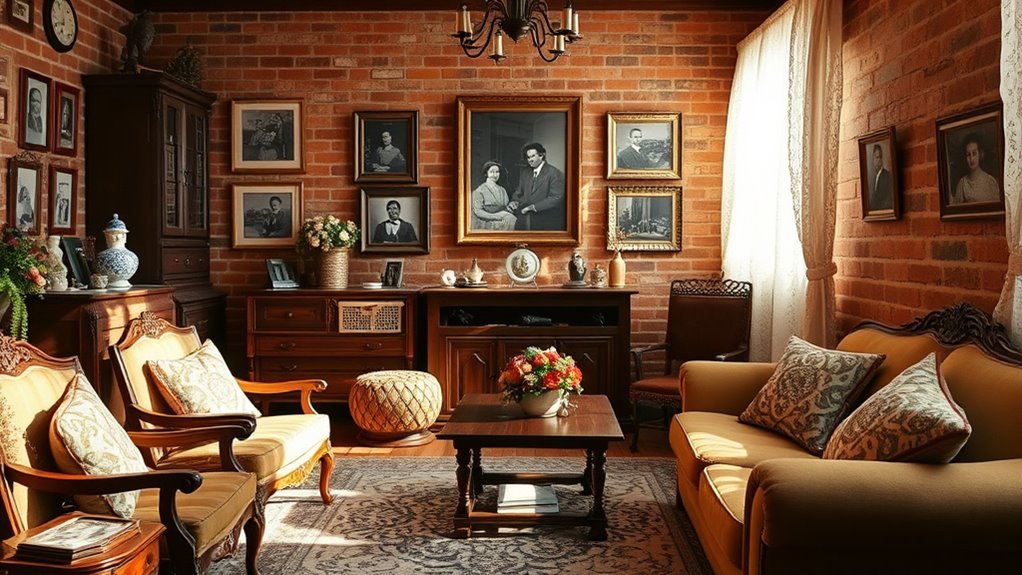
Cultural nostalgia plays a powerful role in shaping current interior design trends by reviving traditional motifs, craftsmanship, and regional aesthetics rooted in specific histories. These elements help you create a home decor style that reflects cultural identity and collective memory. Different regions emphasize unique nostalgic details, like Victorian accents in Britain or folk art from Eastern Europe, influencing regional interior design preferences. Historical events, such as post-war recovery or national pride, inspire decor motifs that foster a sense of belonging. Additionally, vintage and heirloom furniture resurgence highlights cultural values of heritage and continuity. Trends like cottagecore and retro revival romanticize past lifestyles, emphasizing craftsmanship and tradition. This cultural nostalgia enriches your home decor, making it a meaningful reflection of shared history and identity.
- Revival of traditional motifs and craftsmanship
- Regional aesthetics rooted in history
- Influence of collective memories and events
- Vintage and heirloom furniture trends
Balancing Sentimentality With Modern Aesthetics
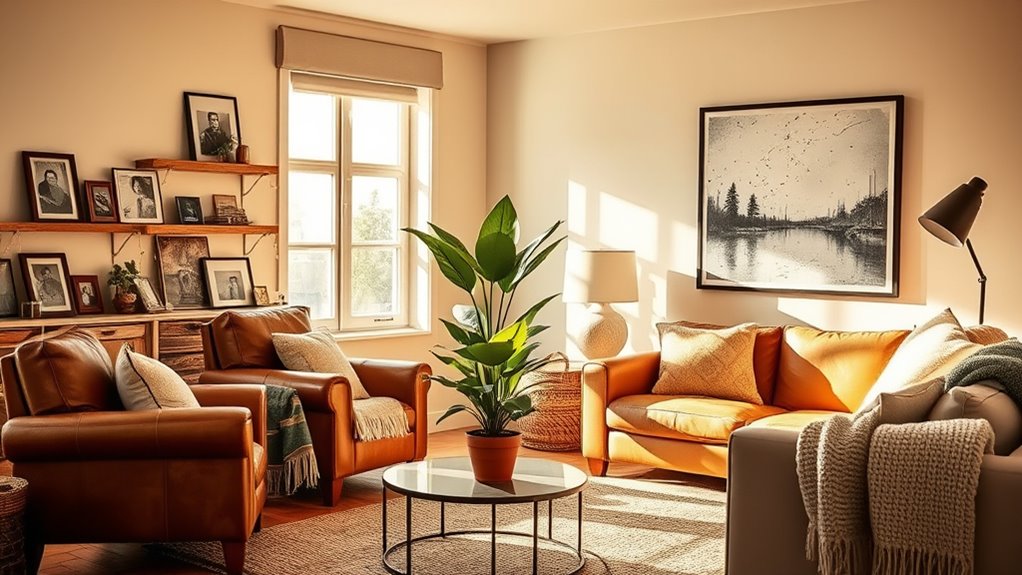
Balancing sentimentality with modern aesthetics requires thoughtfully blending nostalgic elements, like vintage furniture or heirlooms, into contemporary spaces to achieve a cohesive and timeless look. In your interior design, focus on integrating personal memorabilia with sleek, minimalist decor to enhance emotional well-being without sacrificing visual appeal. Use strategic color schemes and neutral backgrounds to let nostalgic accents stand out while maintaining a clean, modern aesthetic. Incorporate modern materials or furniture alongside vintage pieces to foster harmony, respecting personal history while embracing current design trends. Careful curation of sentimental items ensures they complement the overall aesthetic, preventing clutter and preserving the space’s contemporary elegance. This balanced approach creates a harmonious environment that feels both meaningful and stylish.
Practical Ways to Incorporate Nostalgia Into Your Home
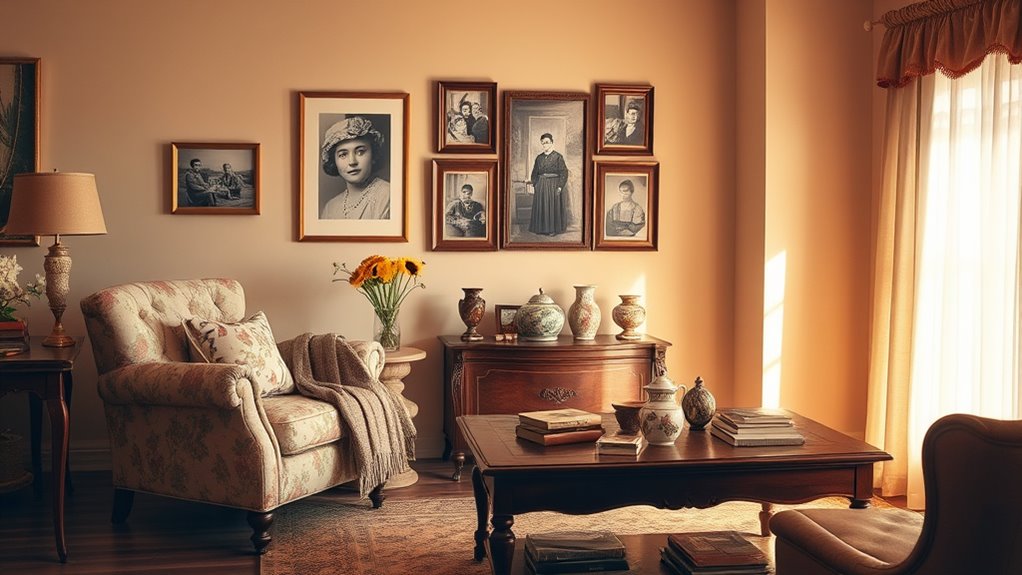
Incorporating nostalgia into your home can be both meaningful and stylish by using personal mementos and vintage pieces. This taps into the power of nostalgia in home design, creating a space filled with comforting memories. To do this effectively, consider these practical steps:
Infuse your home with warmth and personality using vintage finds and cherished keepsakes.
- Display photographs, heirlooms, or travel souvenirs to evoke positive memories and add personal charm.
- Incorporate vintage or retro furniture, like antique lamps or classic textiles, for a sense of history.
- Use warm, earthy colors and nostalgic patterns such as florals or stripes to reinforce a cozy atmosphere.
- Showcase collections on open shelves or mantels, telling stories and fostering emotional connections.
Blending these elements helps balance the past with the present, making your home both inviting and meaningful.
Frequently Asked Questions
How Does Nostalgia Influence Modern Interior Design Choices?
Nostalgia influences your modern interior design choices by guiding you to incorporate familiar, comforting elements from the past. You might choose vintage furniture, retro patterns, or sentimental decorations that evoke positive memories. These choices create a cozy, inviting atmosphere and help you connect emotionally with your space. By blending old and new, you personalize your home while honoring cherished memories, making it feel uniquely yours.
Can Nostalgic Decor Help With Feelings of Homesickness?
Imagine stepping into a room that feels like a cozy, vintage radio broadcast from the 40s—that’s the power of nostalgic decor. It can definitely help with homesickness by creating a comforting, familiar environment that reminds you of better times. Your surroundings become a sanctuary, easing feelings of loneliness and longing. Nostalgic touches connect you to your past, making your current space feel more like home, even when you’re far away.
What Are Common Symbols Used in Nostalgic Home Decor?
You’ll find that common symbols in nostalgic home decor include vintage photographs, antique furniture, and retro posters. You might also incorporate cherished heirlooms, old-fashioned appliances, and nostalgic toys. These elements evoke memories and feelings of the past, making your space feel warm and familiar. By blending these symbols, you create a cozy atmosphere that connects you to your personal history and brings comfort and joy to your home.
How Do Cultural Differences Affect Nostalgic Design Preferences?
Cultural differences shape your nostalgic design preferences by influencing which symbols, colors, and styles resonate with you. You might feel drawn to vintage European furniture or traditional Asian motifs, depending on your background. These cultural elements evoke personal memories and emotional connections, making your space uniquely meaningful. By embracing these diverse influences, you create a home that reflects your identity and celebrates your heritage with authentic, nostalgic charm.
Is There a Risk of Overusing Nostalgia in Home Decor?
Oh, the peril of turning your home into a vintage museum! Overusing nostalgia can make your space feel more like a time capsule than a cozy retreat. You risk overwhelming your senses with too many relics, losing your personal style. Balance is key—mix old with new, so your décor feels nostalgic, not nostalgic to the point of suffocation. Keep it fresh, not fossilized!
Conclusion
Just like a warm fire on a cold night, embracing nostalgic décor can comfort your soul and bring your past into the present. By thoughtfully blending cherished memories with modern style, you create a space that feels both familiar and fresh. Remember, your home is your personal tapestry—each piece a story. So, invite your memories in and let them softly whisper the timeless song of belonging and peace.


